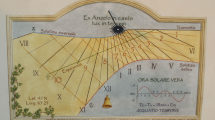Abstract
We designed and constructed a sundial for the purpose of observing the declination of the sun and thus marking solar seasonal variation. The 122 × 122 cm vertical sundial on the south-facing wall of our library has two unusual features: a nodus on the gnomon that casts a shadow of a point for marking the height of the sun and a large blank working space for students to mark the shadow of the nodus at different hours of the day and to connect the marks of 1 day in a line of declination. We discuss the design of a dial that emphasizes a working space for observations on solar declination, methods for determining the position of the nodus such that lines of declination can be observed every day of the year, mathematical procedures that minimize error in laying out the hour lines for this unusual design, the type of materials that are best suited for this design, and how students in an interdisciplinary honors colloquium on seasonal rhythms used the sundial. We also include two appendices on general sundial construction that indicates the information designers need to construct their own sundials.
Similar content being viewed by others
REFERENCES
Aveni, A. (1997). Stairways to the Stars: Skywatching in Three Great Ancient Cultures, Wiley, New York.
Borst, A. (1993). Ordering Time; From the Ancient Computus to the Modern Computer, University of Chicago Press, Chicago.
Daniel, C. St. J. H. (1980). Sundials on Walls, British National Maritime Museum, Greeenwich, UK.
Evans, J. (1998). The History and Practice of Ancient Astronomy, Oxford University Press, New York.
Jevons, W. S. ([1862] 1884). On the study of periodic commercial fluctuations. In Foxwell, H. S. (ed.), Investigations in Currency and Finance, Macmillan, London, pp. 1–12.
Kemmerer, E. W. (1910). Seasonal Variations in the Relative Demand for Money and Capital in the United States, Government Printing Office, Washington, DC.
Klein, J. L. (1995). The ghosts of Octobers past. Wall Street Journal, September 28, A20.
Kussmaul, A. (1993). A General View of the Rural Economy of England 1538–1840, Cambridge University Press, Cambridge, UK.
Lamb, H. H. (1982). Climate, History and the Modern World, Routledge, London.
Le Goff, J. (1980). Time, Work & Culture in the Middle Ages, University of Chicago Press, Chicago.
Malville, J. M., and Cluadia, P. (1993). Prehistoric Astronomy in the Southwest, Johnson Books, Boulder, CO.
Nissenbaum, S. (1996). The Battle for Christmas, Alfred Knopf, New York.
Ottewell, G. (1979). The Astronomical Companion, Guy Ottewell, Greenville, SC.
René, R. J. R. (1996). Sundials: History, Theory and Practice, Dover, Mineola, NY.
Waugh, A. E. (1973). Sundials: Their Theory and Construction, Dover, Mineola, NY.
Author information
Authors and Affiliations
Corresponding author
Rights and permissions
About this article
Cite this article
Klein, J.L., Riskin, A. Learning by the Sun: Observing Seasonal Declination with a Vertical Sundial. Journal of Science Education and Technology 12, 81–88 (2003). https://doi.org/10.1023/A:1022115829592
Issue Date:
DOI: https://doi.org/10.1023/A:1022115829592




